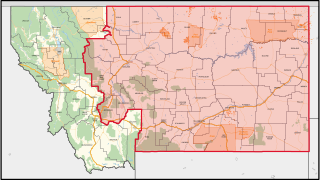| Idaho's at-large congressional district | |
|---|---|
| Obsolete district | |
| Created | 1890 |
| Eliminated | 1919 |
| Years active | 1890–1919 |
From its admittance as a state in 1890 to 1913, Idaho was represented in the United States House of Representatives by one at-large representative. After the 1910 census Idaho was awarded a second seat starting with the 63rd Congress in 1913. However both seats continued to be elected at-large on a general ticket until the election of 1918. Since that year the state has allocated two districts for its representatives.
Vermont's 1st congressional district is an obsolete district. Vermont currently has one representative to the United States House of Representatives, elected statewide at-large. Until 1933, however, the state used to have multiple seats spread out into geographic districts. During that time, the first district elected its own representative.
North Dakota's 1st congressional district is an obsolete congressional district in the state of North Dakota that existed from 1913 to 1933, and from 1963 to 1973.
From its statehood in 1816 until 1823, Indiana was allocated only one representative, who was elected at-large. During the 43rd Congress, from 1873 to 1875, Indiana elected three of its thirteen representatives to the United States House of Representatives at-large from the entire state.
From the time of its admission to the Union in 1812, until the division into multiple districts a decade later, Louisiana had only one congressional district. During that time, three people represented the state at-large.
Pennsylvania's 34th congressional district was one of Pennsylvania's districts of the United States House of Representatives. It covered area north of the city of Pittsburgh, Pennsylvania.
At different times in its history, Washington elected one or more U.S. representatives at-large statewide.
Illinois elected its United States Representative at-Large on a general ticket upon achieving statehood December 3, 1818. It last elected a US Representative in the Election of 1946. The district has been inactive since.
Michigan's at-large congressional district may refer to a few different occasions when a statewide at-large district was used for elections to the United States House of Representatives from Michigan.
During the first twenty-four Congresses, Connecticut elected all its representatives in Congress from a single multi-member Connecticut at-large congressional district.

Montana's 1st congressional district is a congressional district in the United States House of Representatives that was apportioned after the 2020 United States census. The first candidates ran in the 2022 elections for a seat in the 118th United States Congress.
Alabama's 8th congressional district, now obsolete, was established in 1877.
The State of Colorado was represented in the United States House of Representatives by one member of the House, elected at-large from 1876 until 1893 and from 1903 until 1913, and by two members at-large from 1913 until 1915. Since the 1914 elections, all members from Colorado have been elected from congressional districts.
Florida's at-large congressional district may refer to a few different occasions when a statewide at-large district was used for elections to the United States House of Representatives from Florida. The district is obsolete.
During the 35th through 37th Congresses, Minnesota elected its two members of the United States House of Representatives at-large statewide on a general ticket. Minnesota then elected a member to an at-large seat 1913-1915, with the remaining nine representatives elected in districts. Minnesota elected all its members at large for the 73rd Congress, ending the practice two years later.
West Virginia gained a sixth seat in the United States House of Representatives after the 1910 census, but failed to adopt a new redistricting plan immediately. In 1912 and 1914, the state elected Howard Sutherland at-large from the entire state, in addition to its five districted representatives.
Alabama's 10th congressional district is an obsolete district which existed from 1917 until 1933. Its sole representative was William B. Bankhead.

Montana's second congressional district is a congressional district in the United States House of Representatives that was apportioned after the 2020 United States census. The first candidates ran in the 2022 elections for a seat in the 118th United States Congress.

Idaho's 2nd congressional district is one of two congressional districts in the U.S. state of Idaho, in the eastern portion of the state. Beginning with the 2012 election, the district expanded westward and now includes most of Boise, the state capital and largest city. The district is currently represented by Mike Simpson, a Republican of Idaho Falls. A former dentist in Blackfoot, he was first elected in 1998; the seat opened when his predecessor Mike Crapo successfully ran for the U.S. Senate.

Idaho's 1st congressional district is one of two congressional districts in the U.S. state of Idaho. It comprises the western portion of the state. The 1st district is currently represented by Russ Fulcher, a Republican from Meridian, who was first elected in 2018, and re-elected in 2020 and 2022.
Oklahoma's 7th congressional district was a district that existed from 1915 through 1953, covering the southwestern portion of the state.